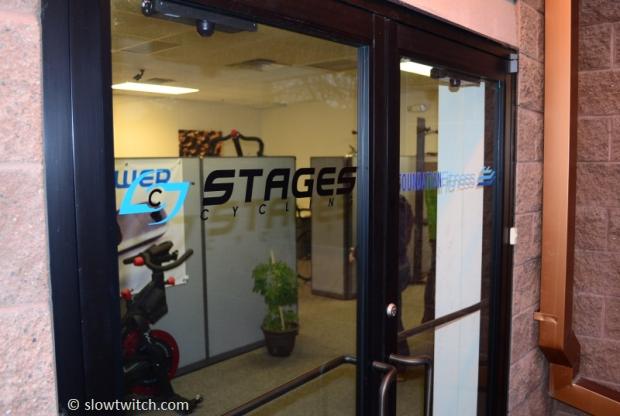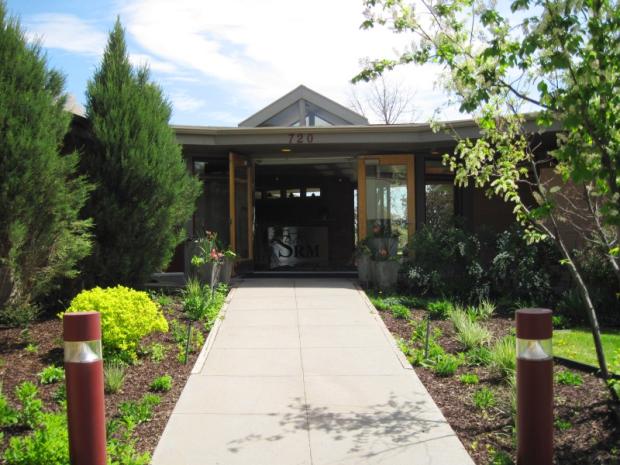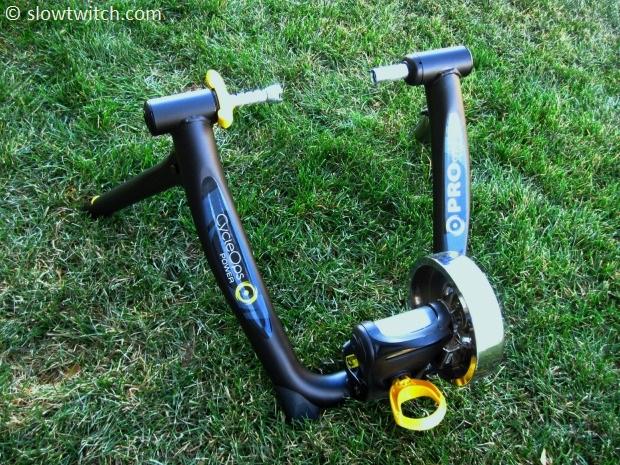Stages Cycling preview
What’s that, you say? A new power meter? A new system for quantifying the kilowatts you’re pumping out of those meat pistons? And – it sells for less than $1,000 US? Where do I sign up?
Some of you may have heard of Stages Cycling. Some of you have not. We’d like to offer a quick overview of their product, which debuted at Interbike in September of 2012. The short of it is this: it’s a crank-based power meter. The product itself is called Stages Power. It’s assembled in the USA by a US-based company. The staff includes several people that worked together at Schwinn, Schwinn Indoor, and Nautilus. The price? Depending on model, you’re looking at $699 to $999 for the system (note – you must supply your own head unit). When are they available? Right… now. As in – they start shipping today.
To the left of this text, you may notice some images. These images were taken on Monday, January 21st at the Stages Cycling press event in Boulder, CO. In typical industry fashion, a handful of journalists were invited to check out the product, meet the staff, go on a ride with the product (in fact – an uphill time trial up to test our FTP), and tour the factory. We will get in to the specifics of this visit later in an in-depth product review – but for now, we wanted to share the images and a few key product details.
Is the product legitimate? Is it as accurate as your beloved SRM, Powertap, Quarq, or other established power-measuring system?
In short, I found the product to be compelling. I believe it also has some compromises (but so do the other systems on the market). I’ll outline what I feel are the key advantages of the Stages system:
1. Price. You can’t get around sub-$1,000 for a crank-based system.
2. Simplicity. No magnets, wires, or other mess to install. Requires a standard (user-replaceable) CR2032 battery, good for 200 hours of use.
3. Weight. Sub-20 grams.
4. Data transmission. It sends both ANT+ and Bluetooth signals. What’s the big deal there? ANT+ can only be received once per second by the head unit. Bluetooth can send and receive 64 times per second. While this doesn’t necessarily have a lot of application for an Ironman, it is a potential huge advantage for track cycling or BMX (where very short efforts can be analyzed in-depth). Stages believes that this is the future, where Apps are a blank canvas to create any analysis software imaginable.
5. Wheel choice.
What about compromises? The obvious first is that it’s an unproven product – at least as far as the public is concerned.
Second, it doesn’t fit every single frame on the market. Compatibility issues tend to arise more with long-travel full suspension mountain bikes, which often have complicated and/or bulky linkage to deal with. Stages told me they're working on a list of incompatible frames, which they will publish on their website.
Last, the system only measures left leg power. How does that work? They simply double it. In contrast, SRM, Quarq, and Power2Max measure flex at the crank spider; which takes forces from both left and right arms in to account.
To test the system accuracy, I’ve been riding it in tandem with a CycleOps Powertap SL+ rear hub, sending data to multiple head units. I’ve done two measured rides in this fashion, and the average power between the two files has been within 3% on both occasions. Stages quotes +/- 2% accuracy of measured left leg power at 100 watts and 90 rpm. CycleOps quotes +/- 1.5%. There is a possibility that some of this discrepancy is due to drivetrain power losses (the Stages reported slightly higher numbers than the Powertap on average). Just looking at the two power files from a bird’s eye view, they definitely trend very similarly – peaks and valleys follow as you’d expect. That being said, this is a VERY simplified overview of the accuracy topic; we will divulge many more details in our in-depth review.
Miscellaneous Notes
Stages only offers their system for aluminum crank arms. Why? Their system relies on Mylar foil strain gauges to measure bending – which is then translated in to your power output. For accurate and consistent performance, strain gauges must be applied to metal (i.e. steel, aluminum, etc) – and aluminum is the lightest choice. If you look at competitors systems such as SRM or Quarq, their crank spiders are aluminum (which is the location that their strain gauges are applied to). Because Stages is applying their system to the arm itself, the whole arm must be aluminum. If you want to use the Stages system with your SRAM Red GXP crankset, you can do so – but you must use a Rival left arm.
Can I transfer the system between different crankarms? What if I have Ultegra cranks on my bike and buy a Stages Ultegra… but then I buy a Cannondale crankset in two years? Can I move the system to the Cannondale crank?
-You cannot. The system gets permanently bonded in place. Additionally, the shape of the power meter is unique to each crank arm shape, so they are not interchangeable.
Can I send in my own crankarm to the Stages factory – for them to apply a power meter to?
-Unfortunately, no. They sell only new arms assembled in their factory. Authorized dealers can receive a ‘core charge’ if they send in a new left crank arm that was taken off of a new complete bicycle (if they sell that bicycle with a Stages Power system).
Does Stages sell complete cranksets, or only left crank arms?
-Stages primarily sells left crank arms, but they do offer complete cranksets in some models. See the complete price list below.
What crank lengths are available?
-Stages will offer a the full size run of every model. For example, they stock every single Shimano Dura Ace size – 165, 167.5, 170, 172.5, 175, 177.5, and 180mm. In contrast, SRAM does not offer 167.5 and 177.5 in Rival, so the list includes 165, 170, 172.5, 175, and 180mm.
How does the Stages meter measure power and cadence if there is no frame magnet or crank magnet?
-Competitors such as SRM and Quarq are ‘event-based’. Reed switches on the back of the crank spider send a signal when they pass by a stationary magnet that is on your frame. This tells the computer when each revolution of the crank happens – so it can calculate things like average torque per revolution. Stages is different in that it relies on an accelerometer inside of the unit. During the calibration process, they tell the accelerometer where certain points are, such as 3 o’clock and 6 o’clock in the pedal stroke. According to Stages, once the power meter knows this, it can determine its position dynamically throughout the pedal stroke – similar to how your smart phone uses an accelerometer to know which way to orient the screen when you rotate it. This is also used to determine your cadence.
Cannondale BB30 Products:
Cannondale Hollowgram SI SL (pre 2012, road/mtn power meter only), $949.99
Cannondale Hollowgram SI SL2 road/mtn power meter, $999.99
Cannondale Hollowgram SI SL2 road, complete crank, $1,399.99
Cannondale Hollowgram SI HG (3D forged) road/mtn power meter only, $799.99
Shimano Products:
Shimano Dura-Ace 9000, $899 power meter; $1349 complete crank
Shimano Dura-Ace 7900, $899 power meter
Shimano Ultegra, $799 power meter; $1099 complete crank
Shimano 105, $699 power meter
Shimano Dura-Ace Track, $899 power meter
Shimano XTR, $899 power meter
Shimano XT, $799 power meter
Shimano Saint, $899 power meter
Shimano DXR, $899 power meter
SRAM Products:
SRAM X9 GXP, $699 power meter; $899 complete crank (Compatible with X7, X9, X0, XX [166 Q model], XX1 and many Truvativ models)
SRAM X9 BB30, $699 power meter; $949 complete crank
SRAM Rival OCT GXP, $699 power meter; $899 complete crank (Compatible with Apex, Rival, Force, Red, and many other Truvativ models)
Stages Cycling PMP plan (Power Meter Protection – extended service)
Stages Cycling will offer a 2-year accidental damage replacement program for the above product at the following prices, which correspond to our three tiers of power meter MSRP pricing.
$105: for products with an MSRP of $699
$120: for products with an MSRP of $799
$135: for products with an MSRP $899 and above
All images © Greg Kopecky / slowtwitch.com
This poster is in the entryway of the Stages office in Boulder, CO. As you can see, the device bonds to the inner side of the left crankarm.
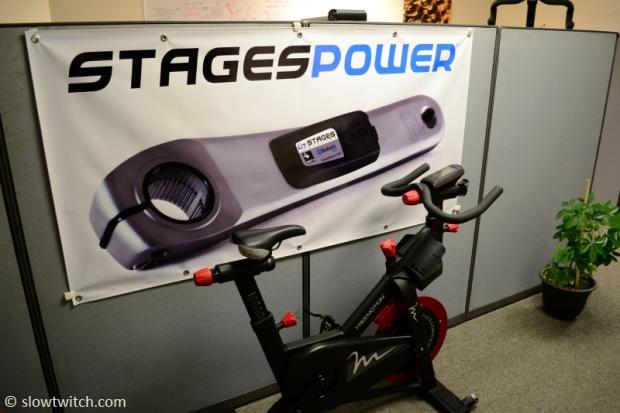
The other half of Stages is called Foundation Fitness. They sell power-measuring indoor cycles to large gyms. Ever wonder what wattage you put out in spin class?
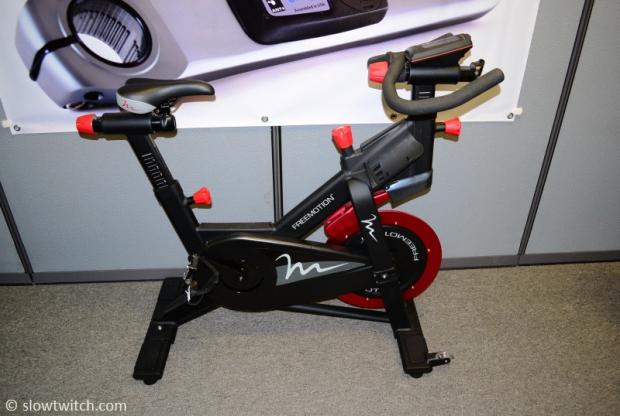
This is the power meter that goes on their indoor fitness cycles. As you can see, it is much larger than the Stages Power meter (but the design concept is similar).
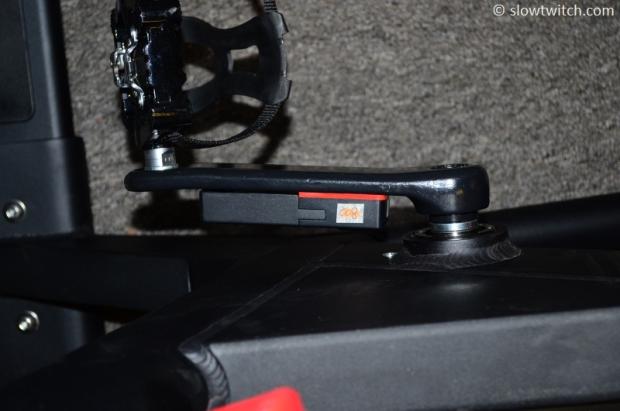
Someone in the Stages office is doing their homework.
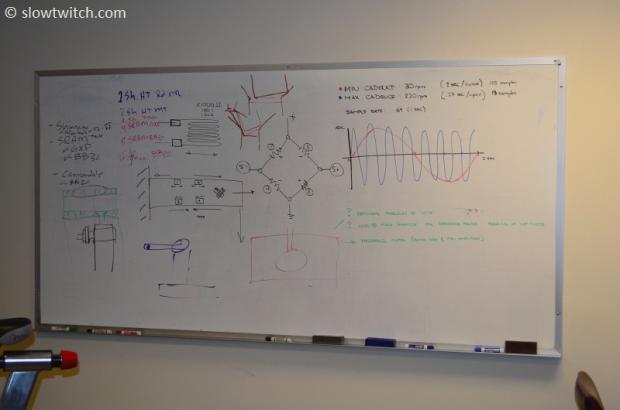
The factory and warehouse feature quite a lot of inventory.
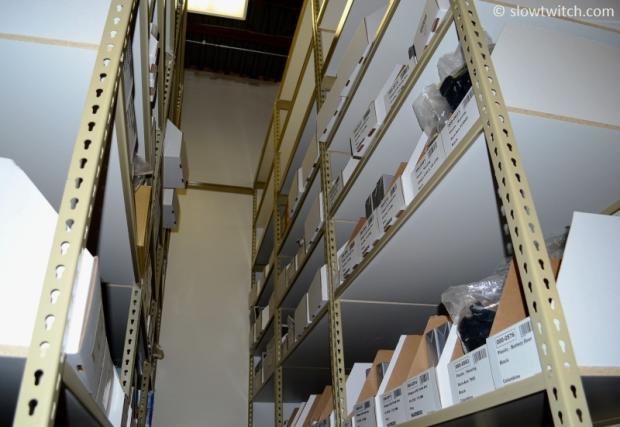
Short crank riders rejoice – Stages has full inventory, down to 165mm.
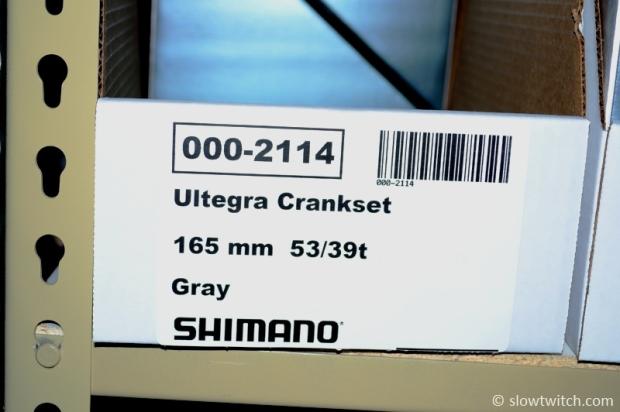
They also accommodate long-legged gear mashers.
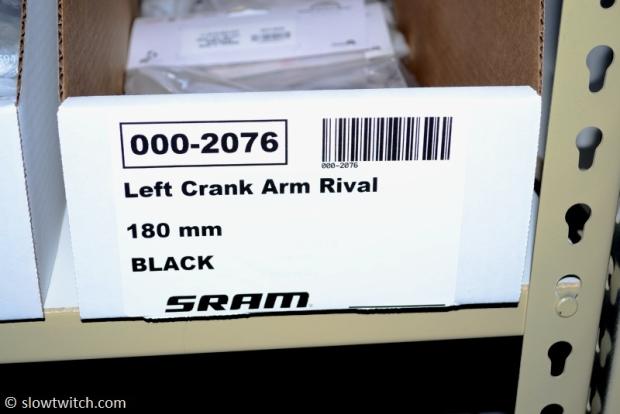
Stages does quite a bit of in-house testing. Can you put out 400 watts for two weeks straight?
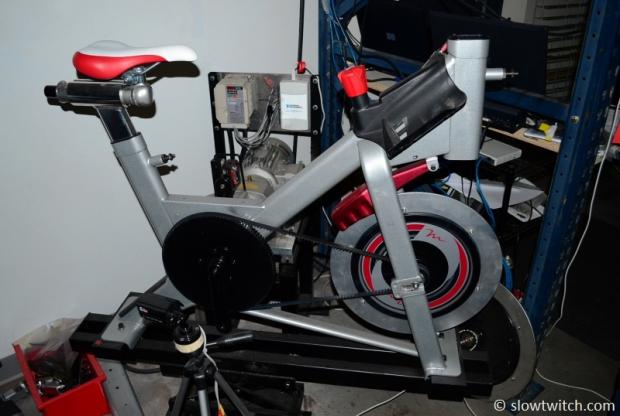
All of the test data gets recorded.
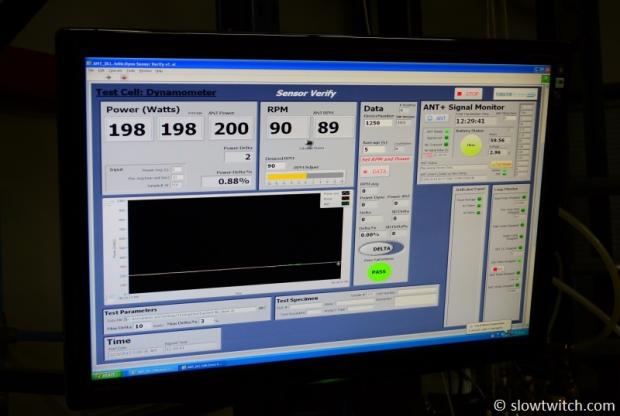
They even do fatigue testing for their own sub-components. This handlebar is from an indoor cycle, and went through a series of torture tests.

The factory also has its own large machine shop – including some vintage Schwinn tools.

More testing and inventory in the machine shop.
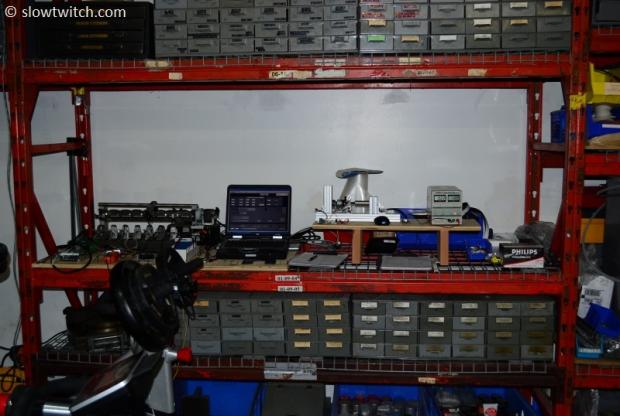
These systems are packed and ready to go.

Notice something missing here?
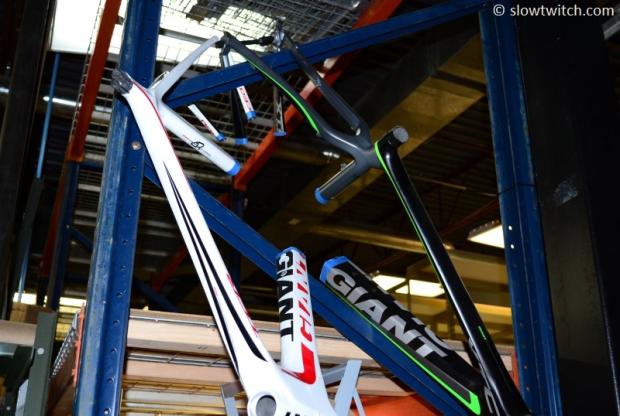
Two Giant frames were sacrificed to become the first Stages display at Interbike 2012.
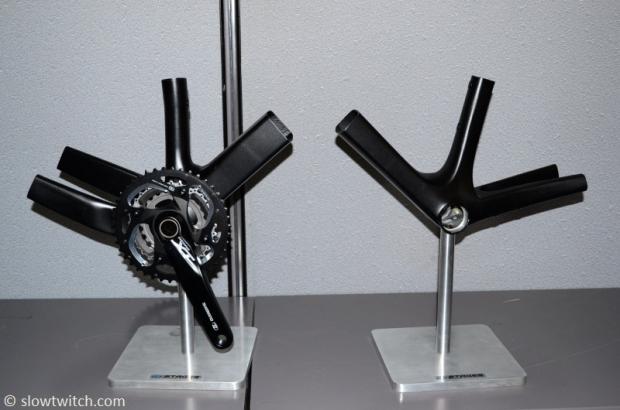
This is a fun conference room table. The glass table top even has carbon wheels underneath it.
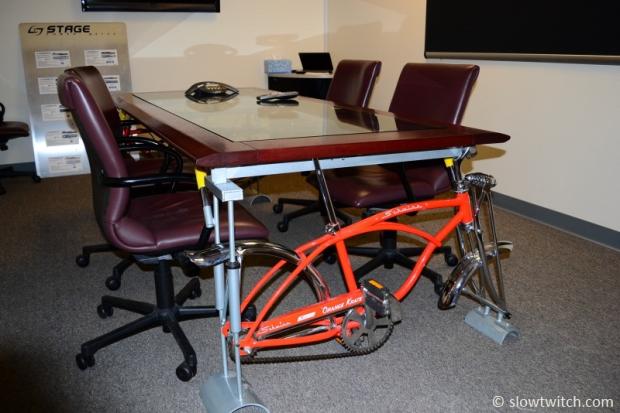
Yes – you can even use a power meter on your downhill mountain bike.
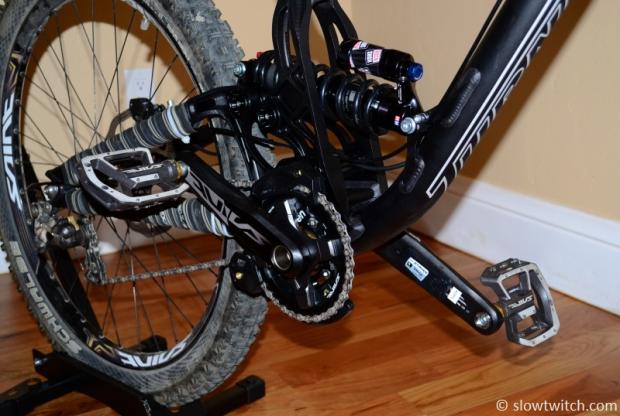
Dirk Friel and several others from TrainingPeaks were present at the Stages event in Boulder. They offered post-ride analysis after our uphill TT effort.
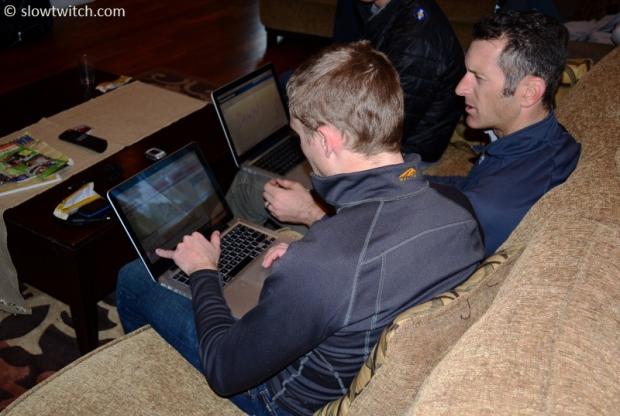
There are many models and lengths to choose from.
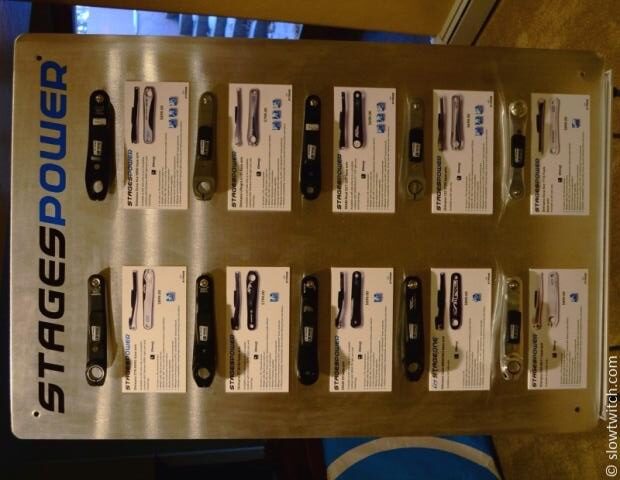
The Stages Cycling factory is located in the heart of Boulder, CO. They also have a satellite office in Portland, OR.
